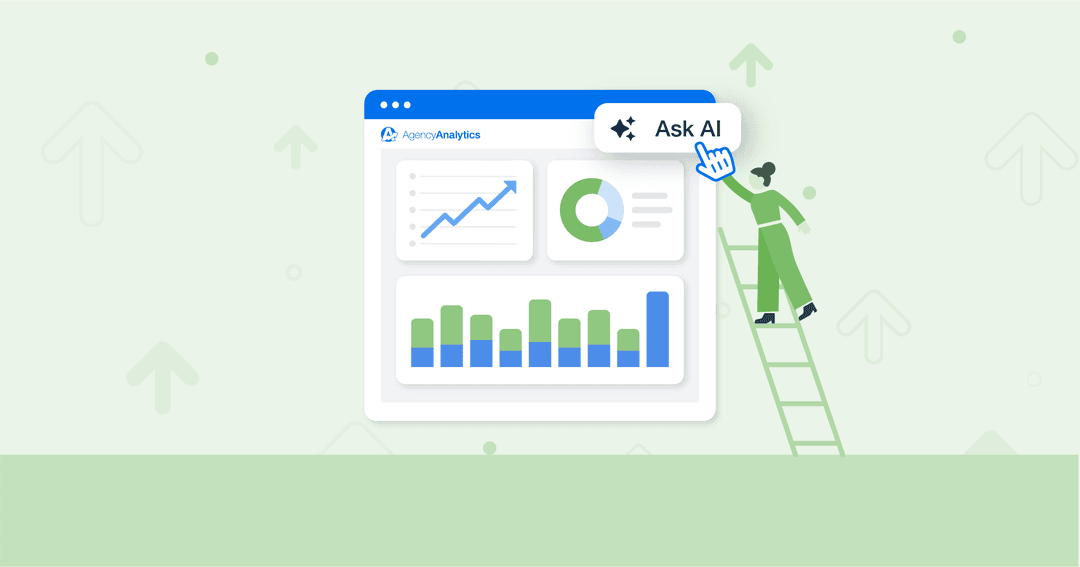Table of Contents
QUICK SUMMARY:
AI data analysis helps marketing agencies quickly process large datasets, uncover insights, and optimize client strategies. AgencyAnalytics recently launched Ask AI and AI Summary to offer these capabilities. Together, these data analysis tools enable agencies to generate actionable insights, areas of improvement, and interesting data findings. This article explains the advantages of using AI in data analysis and how to use AI-powered features in the AgencyAnalytics platform.
From tweaking that last Google Ads bidding strategy to monitoring your client’s SERP position, it often feels like your to-do list is never-ending. That’s why the majority of agencies are adopting a variety of AI data analysis tools to help speed the workflow along.
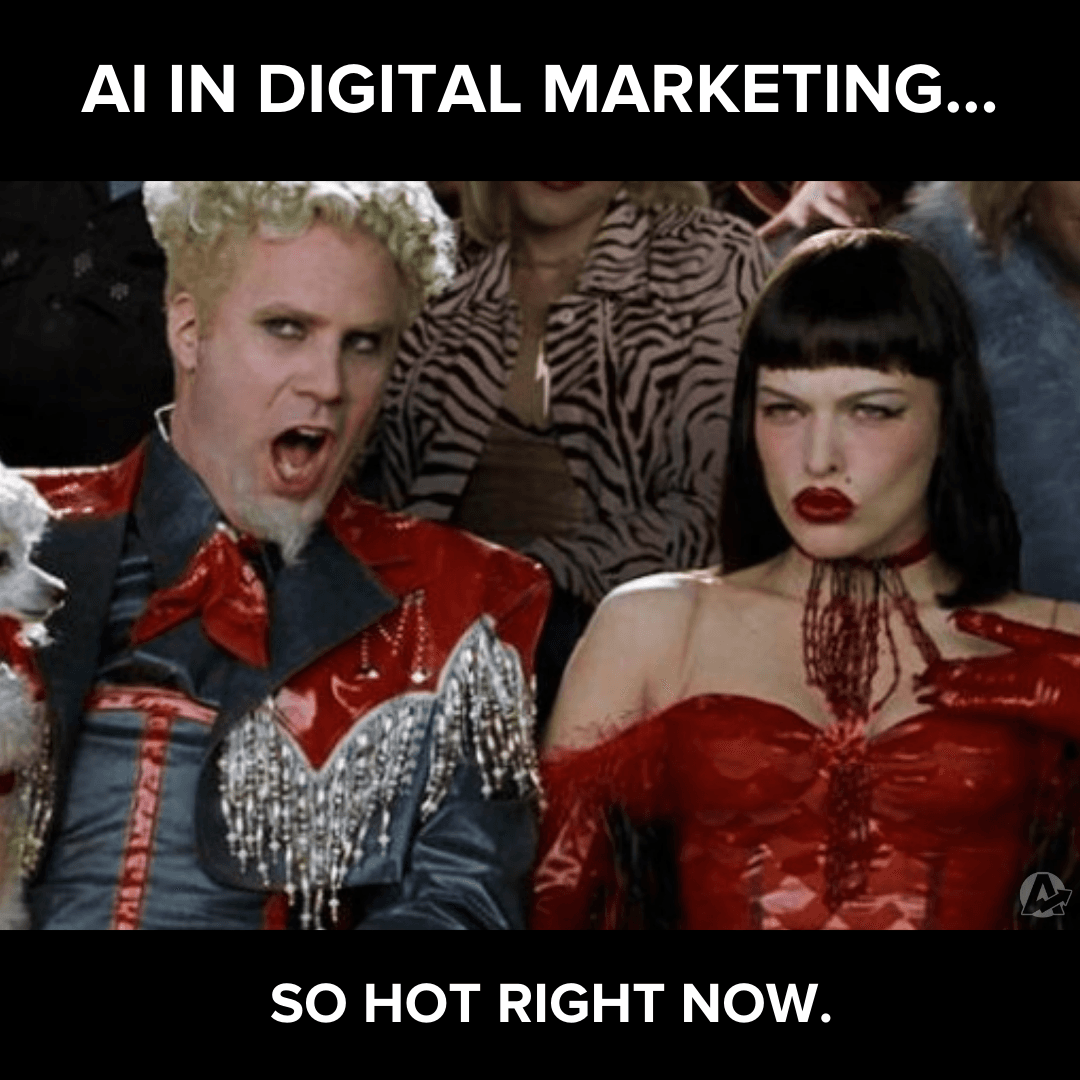
After you’ve run those campaigns, there’s one thing left (and arguably the most important of all)–reporting on the results. The good news is that AI data analysis tools are a boon for client reporting too, saving your agency time and helping to surface in-depth insights in a fraction of the time.
AgencyAnalytics provides countless benefits, like automatic data retrieval, intuitive data visualization, and access to 80+ integrations. It removes the hassle of manual data collection, leaving you with more time to actually do the work.
And now, our new AI-powered data analysis features make it easy for agencies to use the Ask AI and AI Summary tools to access quick (and valuable) insights. Highlight campaign wins, identify optimization opportunities, and generate a high-level snapshot of performance–all in a few seconds.
In this article, we’ll explore why agencies should use AI for data analysis tasks, along with how to leverage these new features in AgencyAnalytics.
What Is Data Analysis in AI?
Wondering what this term actually means? To break it down further:
Data analysis in AI refers to the process of using artificial intelligence to analyze and interpret marketing performance. This involves processing large volumes of data, generating actionable insights, and identifying patterns to inform decision-making.
More specifically, AI-powered data analysis is used to predict future trends, identify areas for optimization, and highlight those not-so-obvious wins. It’s also a proactive way to flag potential issues before they impact client campaigns, which helps your agency stay on top of things at all times.
AI algorithms rely on large and complex data sets to learn and improve their accuracy over time. By utilizing past performance metrics as training data, agencies will enhance the quality of predictive insights over time.
While traditional data analytics relied on human learning, AI data analytics uses machine learning algorithms to convert metrics from various data sources into deeper insights. To sum things up, here’s exactly why data analysis in AI is so handy.
Benefit | Description |
|---|---|
Data Cleaning and Preparation | Before analysis begins, AI streamlines the data cleaning and data preparation processes by automatically detecting and correcting errors in raw data. This ensures that the data used for analysis is accurate and ready for generating reliable insights. |
Analyze Large Data Sets in a Few Seconds | With AI, it’s easy to automatically process data and save time from doing a manual analysis. Because cross-campaign performance is factored in, it removes data silos and uncovers meaningful relationships across marketing efforts. |
Generate Reasonable Explanations for Data Changes | Use AI-powered data analysis to identify the potential causes behind spikes or drops in metrics (e.g., traffic or conversions). This added context ensures clients have a better understanding of their marketing data. |
Create Plausible Relationships Between Metrics | Use exploratory data analysis to make connections between key metrics like CTR, engagement, and ROI that may be often overlooked. This big-picture analysis shows holistic thinking and leads to more accurate conclusions. |
Identify Trends and Predict Outcomes | Through the use of AI, it becomes much easier to identify emerging trends and predict future performance. Use these insights to plan ahead and optimize campaigns when needed. |
Sound complicated? Don’t worry. You don’t need to be a data scientist to incorporate AI data analysis into your client reporting.
AgencyAnalytics recently released two AI-powered features to offer this exact type of on-demand analysis. With the introduction of Ask AI and AI Summary, agencies won’t have to spend excessive time deciphering marketing results or making sense of unstructured data. Instead, it’s a streamlined way to use advanced data analysis to generate actionable insights, create a brief overview of campaign performance, and enhance the reporting experience. Putting raw data into a meaningful context used to be something only data scientists could do, but not anymore.
Using the AI features in AgencyAnalytics helps us summarize a client report much faster than reading through results, typing up an email, and sending it to the client. The predictive analytics in Ask AI has certainly increased our productivity, helping us to do things much faster.
Kevin Watts, Founder, Raincross
The Not-So-Obvious Benefits of Using AI for Data Analysis
AI-powered data analysis certainly makes the job easier. That said, it’s more than a tactical tool for your reporting efforts. In fact, there are other hidden benefits–let’s explore further.
Access Unbiased Data Insights
Even with the best intentions, human bias is a very real possibility when it comes to manual data analysis. It may be especially problematic when you’ve got a long list of priorities or simply pressed for time. For example, consider the following common scenarios:
Confirmation Bias in Campaign Results: For example, say a Marketing Manager is running a social media ad campaign that’s yielding high engagement but low conversions. To demonstrate campaign success, they may focus on this increased user interaction and ignore the lack of qualified leads.
Recency Bias in Performance Reports: When analyzing performance, a PPC Specialist may be disproportionately influenced by the most recent data (e.g., a sudden spike in conversions over the last few days). However, it may lead them to overemphasize short-term trends, like seasonal influences or campaign fluctuations.
Sunk Cost Fallacy in Strategy Adjustments: If your agency has invested significant time or resources into a particular strategy, there may be a bias to see things through. This could be problematic and lead to compromised results down the line.
In each of these scenarios, AI removes subjective judgment, offering more neutral insights that reflect what’s happening. This approach ensures a balanced perspective while also safeguarding against human error, bias, or data misrepresentation.
Our clients rely on accurate data. Accuracy is extremely important because it allows our clients to make important decisions as the data rolls in, and as an agency, it allows us to advise based on the data for a better return on their investments.
Vinod Samuel, Operations Director, myheartcreative

Automate data analytics tasks, generate data visualizations, and access useful insights in seconds. Explore the latest AI-powered features in AgencyAnalytics–sign up for a free 14-day trial today.
Get Added Support as Your Agency Scales
As your agency grows, investing in sustainable systems and agile processes becomes even more important. After all, you don’t want to be in a situation where you’re adding clients to your roster and can’t handle an increasing volume of data.
With our recently launched AI reporting features at your disposal, there’s now an extra support buffer. It’s designed to reduce reporting times, enhance your internal operations, and even remove the need to hire additional data analysts.
The result? More reclaimed time, faster turnaround times, and a consistent level of service as your business grows.
Winning back billable time is important to our agency's growth because it allows us to focus on activities that generate revenue and add value for our clients. When we are able to streamline manual processes, we can allocate more time to client acquisition, campaign management, and strategy development. It also helps us build stronger client relationships, as we’re able to provide more personalized attention and support.
Daniel Dye, President, Native Rank
To put this in perspective, consider this finding from our last Benchmarks Survey: Most AgencyAnalytics users spend just 15 to 30 minutes creating client reports.

Interestingly, this was before we introduced AI-powered features, suggesting that reporting times could decrease further over time. The future looks promising!
In addition to improving efficiency, it's important to ensure data security. With AI-driven tools, your agency automates data handling while maintaining stringent data security protocols.
How To Use AI-Powered Features To Optimize Reporting in AgencyAnalytics
Now that we've covered the basics of data analysis in AI, here's how to maximize its potential in AgencyAnalytics.
1. Define Your Client’s Goals
There’s no way to measure success without prior goal-setting.
In fact, this foundational step keeps everyone on the same page. Plus, it helps agencies generate AI insights that align with a client’s broader objectives.
We believe that metrics are only useful if they help to drive decision-making. As a result, we focus on identifying actionable metrics that can be used to inform and improve marketing efforts. To do this, we start by taking a close look at goals. Then, we identify the key performance indicators (KPIs) that measure progress towards those targets.
Guy Hudson, Founder, Bespoke Marketing Plans
To get started, consider the following questions:
What are the primary business objectives of this campaign?
What is the timeline for achieving these goals? Are there short-term vs. long-term objectives?
What is the client’s budget, and how does it affect goal-setting?
How does this campaign fit into a broader marketing strategy or business goals?
Are there particular OKRs or KPIs (e.g., ROAS, conversion rates, customer acquisition cost) that reflect these objectives?
Are there any specific channels or platforms that should be prioritized?
What does a successful outcome look like (e.g., achieving specific targets for revenue, leads, or brand awareness)?
Whatever the case, set measurable goals from the start–it ensures clarity and direction for every client campaign.
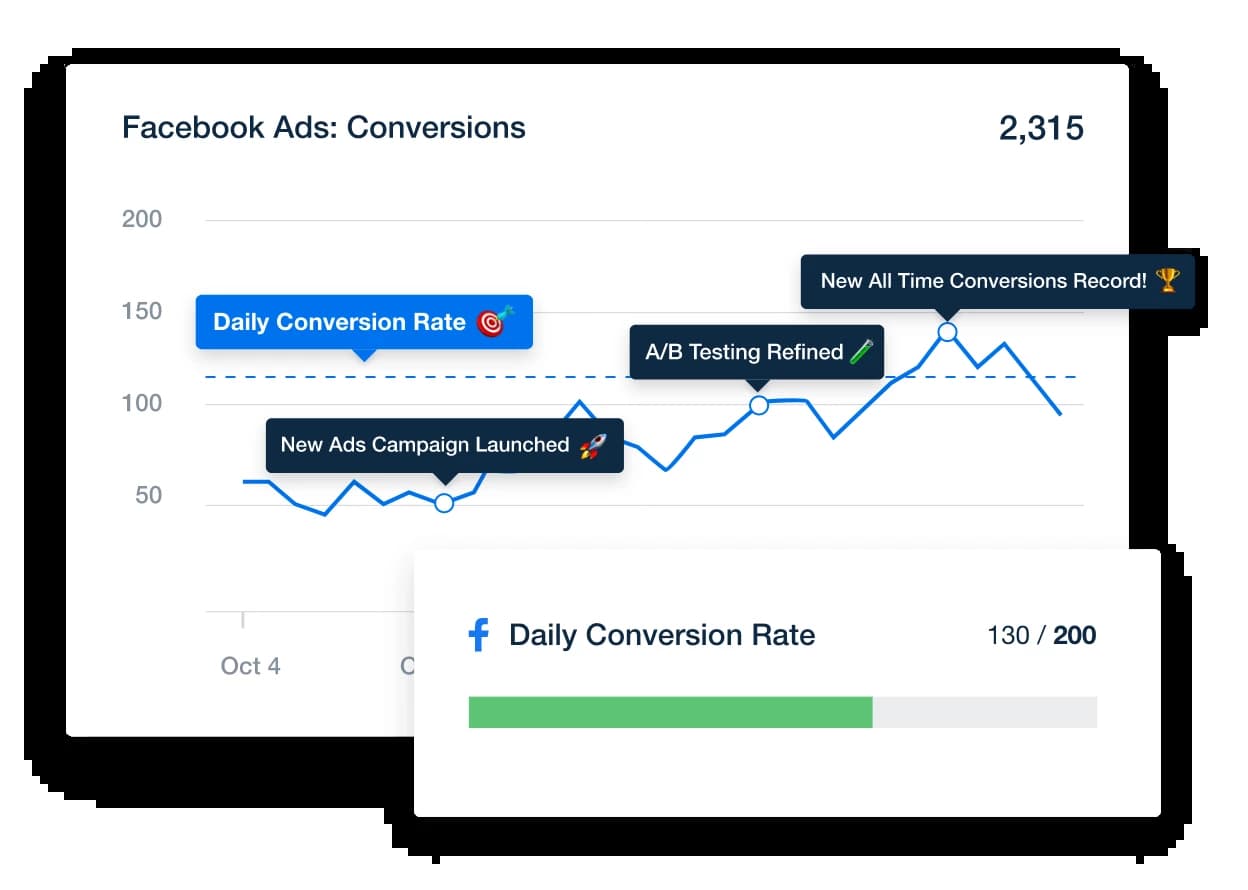
Create dynamic goals, visualize data, and access data analytics AI features. Ready to see what AgencyAnalytics is all about? It’s easy–sign up for a free 14-day trial today.
2. Set up Your Client’s Dashboard or Report
Next, it’s time to create your client’s dashboard or report in AgencyAnalytics.
Wondering what’s the difference between the two? A dashboard is used to keep on the pulse of real-time insights and ongoing campaign performance. In simple terms, this tool helps your agency ensure everything is progressing as planned.
To keep clients looped in and maintain data transparency, consider granting live login access.
We use dashboards to keep our eyes on campaigns and key performance indicators around the clock. We also think our clients should be able to access their insights as well. You can't hide behind dynamic data, so in a way, it pushes us to be the best we can be.
Ashlee Brown, Campaign Performance Manager, i76 Solutions
On the other hand, a report presents a static overview of performance. For some clients, this is a preferred format since it summarizes insights for a specified period (e.g., a month). That way, they’ll have a snapshot of progress without diving into real-time data.
With AgencyAnalytics, you don’t have to choose one or the other. In fact, you’ve got a range of options! For example:
Use a Pre-Built Dashboard or Reporting Template: Automatically stream your client’s metrics into a readymade format, which means you won’t have to create a design from scratch.
Build a Custom Dashboard or Report: Use the drag-and-drop builder to develop something entirely your own–even toggle with data visualizations and import data across 80+ platforms!
Generate a Smart Dashboard or Smart Report. Need to boost your efficiency even more? Use this feature to stream your client’s unique data into a visual, professional format in just 11 seconds!
Sometimes, what’s showing on the Smart Report provides more value than what we had in our report templates. For example, we might present data with a raw number, whereas a Smart Report presents it as a bar chart. That's a better way, so we use those widgets.
Michael Smith, Operation Manager, EOS Healthcare Marketing
3. Use AI To Analyze Data and Provide Useful Insights
Now it’s time for the fun stuff! With Ask AI, agencies have the ability to get instant overviews of campaign performance and enhance the data analysis process.
More specifically, here’s a breakdown of the pre-defined prompts you’ll see:
💡 Tell me something interesting. Curious about any overlooked insights? Use this prompt to uncover noteworthy insights, highlight developing trends, and even understand the relationship between metrics.
🔍 Identify an opportunity. Show clients you’re proactive about their campaigns. Quickly pinpoint areas to capitalize on, like tweaking a PPC bid or adjusting an SEO strategy. This will help your agency to drive better results and share strategic recommendations.
🎉 Celebrate a win. Data speaks for itself–Ask AI to share positive campaign insights and what was achieved. This will reiterate your value proposition, demonstrate ROI, and keep clients coming back for more!
🎯 Highlight an issue. No campaign is perfect. Use this handy AI prompt to investigate any hiccups or identify outliers. Maintain transparency, identify areas for improvement, and build client trust.
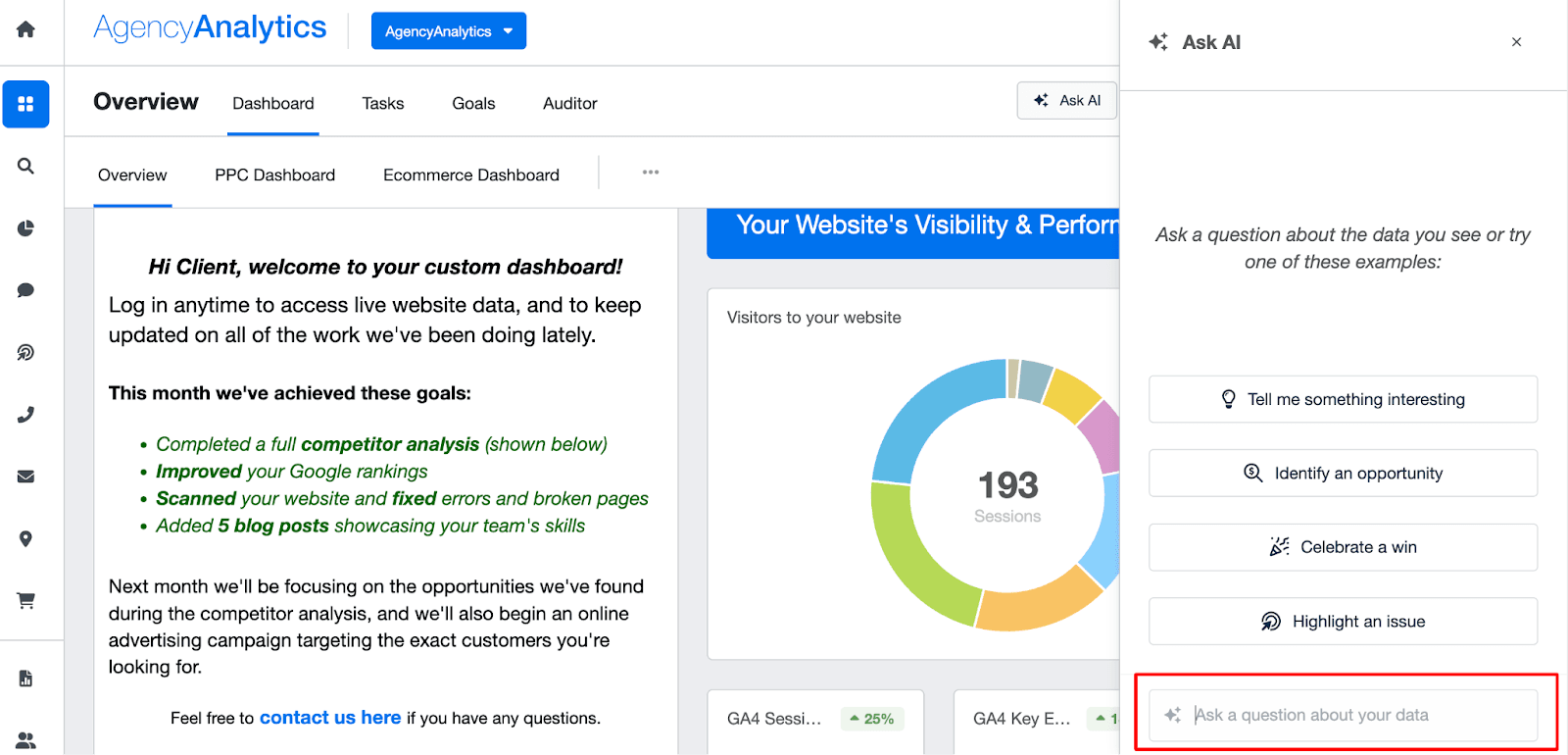
Access predictive analytics and leverage the power of our machine learning models. You don’t need a background in data science to share meaningful insights–try Ask AI in AgencyAnalytics, free for 14 days.
Here’s the best part: You’re not limited to these prompts. Ask AI anything about client reporting (e.g., more granular insights about a specific data point). It’s all up to you!
4. Communicate Your Findings Through a Compact AI Summary
Here’s the thing–your clients are busy. Realistically, they may not have time to delve through the nitty-gritty details of their dashboard or report. To make their lives easier, use the AI Summary feature in AgencyAnalytics! It’s a neat way to auto-generate an overview of campaign performance in just a few seconds.
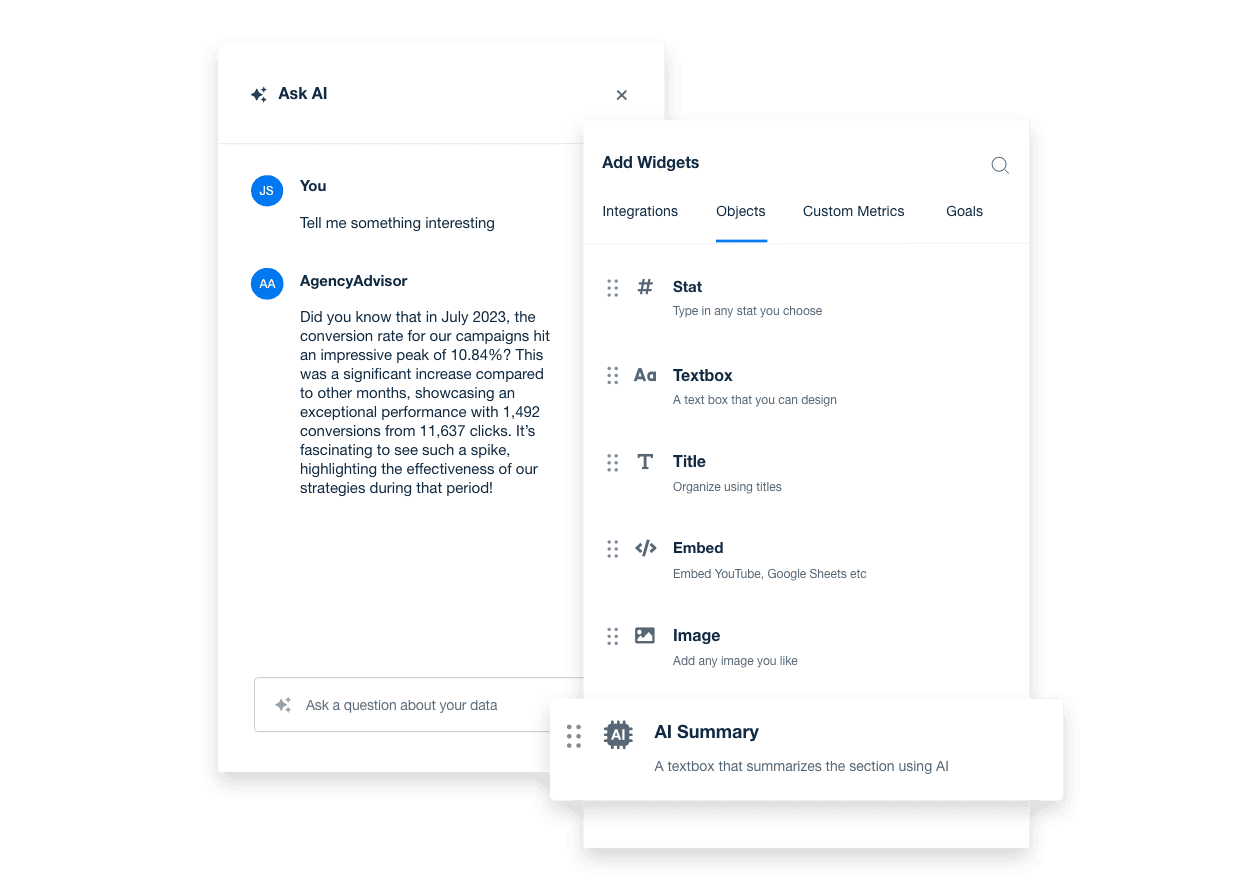
As a best practice, include a summary at the beginning of every report or dashboard. Need to tweak some text? No problem! This summary is fully customizable–simply click the pencil icon at the top right corner and make adjustments as needed.
Use AI Data Analysis To Streamline Reporting and Improve Operational Efficiency
As we’ve covered, AI-powered analytics is a dynamic way to optimize client reporting. Rest assured–it’s not meant to replace your agency’s expertise. Instead, it’s a time-saving feature that complements it, providing a way to speed up report prep and get to the heart of what the data is saying.
There’s no longer a need to spend hours on performance analysis. Instead:
Use Ask AI to identify important insights, spot bottlenecks, highlight wins, and capitalize on opportunities.
Generate an AI Summary to capture key takeaways from your client’s campaign performance.
Get an extra layer of support as your agency scales, reduce operational costs (like hiring another data analyst), and ensure maximum efficiency.
It's more than a fancy AI assistant–it's an exciting development in the evolution of reporting. Help clients make data-driven decisions and deliver valuable insights every time–try AgencyAnalytics today, free for 14 days.

Written by
Faryal Khan is a multidisciplinary creative with 10+ years of experience in marketing and communications. Drawing on her background in statistics and psychology, she fuses storytelling with data to craft narratives that both inform and inspire.
Read more posts by Faryal KhanSee how 7,000+ marketing agencies help clients win
Free 14-day trial. No credit card required.



